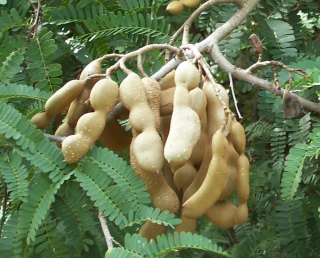
Green Tamarind
Tamarind (Tamarindus indica) is a tropical fruit celebrated for its distinctive sweet-sour flavor. The fruit is encased in a brown, brittle pod that houses a sticky, dark brown-red pulp surrounding several hard seeds. Tamarind is a versatile ingredient, used both fresh and as a flavoring in various culinary applications, particularly in beverages, sauces, and candies.
Botanically, tamarind belongs to the Fabaceae family and is the only species in the Tamarindus genus. The tree is native to tropical Africa, including the Madagascar dry deciduous forests, and grows wild throughout the Sudan. Tamarind trees can reach up to 20 meters in height and remain evergreen in regions without a dry season. The timber consists of hard, dark red heartwood and softer, yellowish sapwood. The leaves are composed of 10–40 leaflets, and the flowers are produced in racemes. The fruit itself is a brown, pod-like legume containing a soft, acidic pulp and numerous hard-coated seeds that can be scarified to enhance germination.
There are two main varieties of tamarind:
Commercial cultivation of tamarind is significant in Mexico, Belize, Central America, northern Brazil, and India. India boasts extensive tamarind orchards, producing approximately 275,500 tons (250,000 metric tons) annually. Tamarind is a staple in Indian cuisine, commonly used in dishes like sambar, chutneys, and lentil soups.

Green Tamarind

Ripe and Green Tamarind
Tamarind's culinary uses are diverse. In beverages, it is used to make refreshing drinks like tamarind juice and agua de tamarindo. It is a crucial ingredient in sauces and condiments, such as Worcestershire sauce, HP sauce, and various Asian sauces. In confectionery, tamarind is used in candies, jams, and desserts for its unique flavor. It is integral to the cooking of Indian, Thai, Mexican, and Caribbean cuisines, featured in dishes like pad thai, chutneys, curries, and stews.
Tamarind is a cherished fruit with a rich history, diverse culinary applications, and significant nutritional benefits. Its global spread and cultural integration make it a fascinating subject of study and an essential ingredient in many traditional and modern dishes.

Ripe Tarmarind

Tamarind Balls

Tamarind Drink